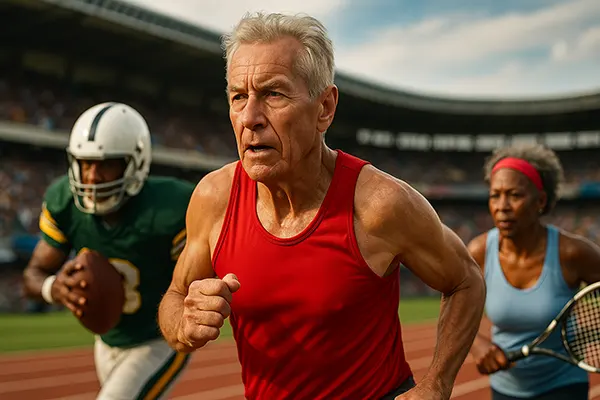
Restoration of Legends: How Senior Athletes Return to Major Sports
In the dynamic world of sports, stories of legendary athletes making remarkable comebacks have always captured public imagination. Recently, a surge of veterans rejoining professional arenas like football, tennis, and boxing has reignited discussions on the possibilities and challenges of such returns. Names like Tyson Fury and Serena Williams stand as strong examples, inspiring fans worldwide with their enduring spirit and resilience. This article explores notable comeback stories, the rigorous preparation behind them, and why audiences are so captivated by these heroic journeys.
Iconic Comebacks Across Various Sports
Across different sporting disciplines, we witness awe-inspiring comebacks that transcend age barriers. In boxing, Tyson Fury’s triumphant return after battling personal struggles stands out; he reclaimed his heavyweight title, showing that mental fortitude can conquer immense odds. In tennis, Serena Williams’ persistent drive to compete at the highest level post-maternity leave is a testament to her exceptional skills and enduring passion for the sport. Similarly, football has seen veterans like Zlatan Ibrahimović, who, despite being over 40, continues to play at an elite level, inspiring younger generations with his stamina and leadership.
Beyond individual sports, entire leagues and clubs actively encourage the return of experienced athletes. Veteran players bring invaluable leadership and tactical knowledge, enhancing team dynamics significantly. In Major League Soccer (MLS), stars like Lionel Messi, despite being at the later stages of his career, have reignited global interest and brought fresh energy to the league.
Another area worth mentioning is basketball, where players like LeBron James defy conventional career lengths by maintaining peak performance into their late thirties and beyond. Their success stories reshape traditional views on athletic longevity and recovery.
Physical and Psychological Preparation for Veterans
Returning to competitive sports at an advanced athletic age requires exceptional physical preparation. Tailored training programmes that focus on injury prevention, endurance, and flexibility are crucial. Sports science advancements, including recovery therapies and personalised nutrition, play a vital role in extending athletes’ careers and improving performance after breaks.
Equally important is psychological resilience. Many returning athletes undergo mental conditioning, working with sports psychologists to regain competitive confidence and manage pressure. Mental stamina often becomes their biggest advantage, outweighing minor physical declines.
Support systems, including family, coaches, and medical professionals, also become critical. Building a network that fosters emotional stability and motivation greatly influences the success of a veteran’s comeback journey.
Why Fans Celebrate the Return of Legends
Fans are naturally drawn to comeback stories because they embody hope, resilience, and the human ability to overcome challenges. Watching a beloved athlete rise again after setbacks reinforces positive narratives of perseverance, something that resonates deeply on a personal level for many supporters.
Moreover, returning legends often bridge generations. Young fans hear about historic achievements from older relatives, and seeing these athletes back in action creates a tangible link between the past and present. This continuity enriches the cultural heritage of sports fandom and promotes multigenerational engagement.
There is also an undeniable thrill in witnessing history being rewritten. Every match, race, or fight that features a returning legend carries a heightened sense of significance. The stakes are not only professional but emotional, with fans investing themselves fully in each moment.
Economic and Commercial Impact of Comebacks
From an economic perspective, the return of legendary athletes significantly boosts ticket sales, viewership ratings, and merchandise purchases. Clubs and organisers often experience increased revenue thanks to the renewed media attention and expanded fan engagement surrounding these veterans.
Sponsorship opportunities also surge. Brands are eager to associate themselves with powerful narratives of perseverance and achievement, making veteran athletes highly attractive ambassadors even late in their careers. These collaborations often transcend sport, impacting fashion, lifestyle, and wellness sectors.
Furthermore, major sporting events featuring returning legends attract global audiences. This leads to a broader cultural and commercial footprint, reinforcing the global appeal of sports and amplifying their societal significance beyond mere competition.

The Future of Veteran Athletes in Professional Sports
Looking ahead, it is likely that the trend of senior athletes returning to professional sports will only grow stronger. With advances in medicine, training techniques, and mental conditioning, physical decline can be delayed, allowing longer, more impactful careers.
Organisations are also recognising the value of experienced athletes in mentoring younger talents. Programmes that integrate veterans into leadership roles within teams are becoming more common, ensuring their knowledge and inspiration are passed on effectively.
In conclusion, the restoration of sporting legends is not merely a nostalgic phenomenon. It reflects the evolution of sports science, the power of human will, and the enduring passion that binds athletes and fans together across generations.
Challenges Veteran Athletes Continue to Face
Despite all the inspiring stories, returning veterans often encounter unique challenges. Managing expectations — both personal and external — becomes critical. Fans and media may expect immediate high performance, which can add immense pressure on returning athletes.
Physical limitations, although mitigated by science and preparation, still exist. Recovery times are longer, and the risk of injury increases with age. Strategic management of match schedules and rigorous medical supervision are essential to balancing competitiveness and longevity.
Finally, the emotional aspect of re-entering an intensely competitive environment cannot be underestimated. Feelings of self-doubt, fear of tarnishing a legacy, or dealing with changed dynamics in the sport’s ecosystem must be carefully navigated for a successful comeback.
